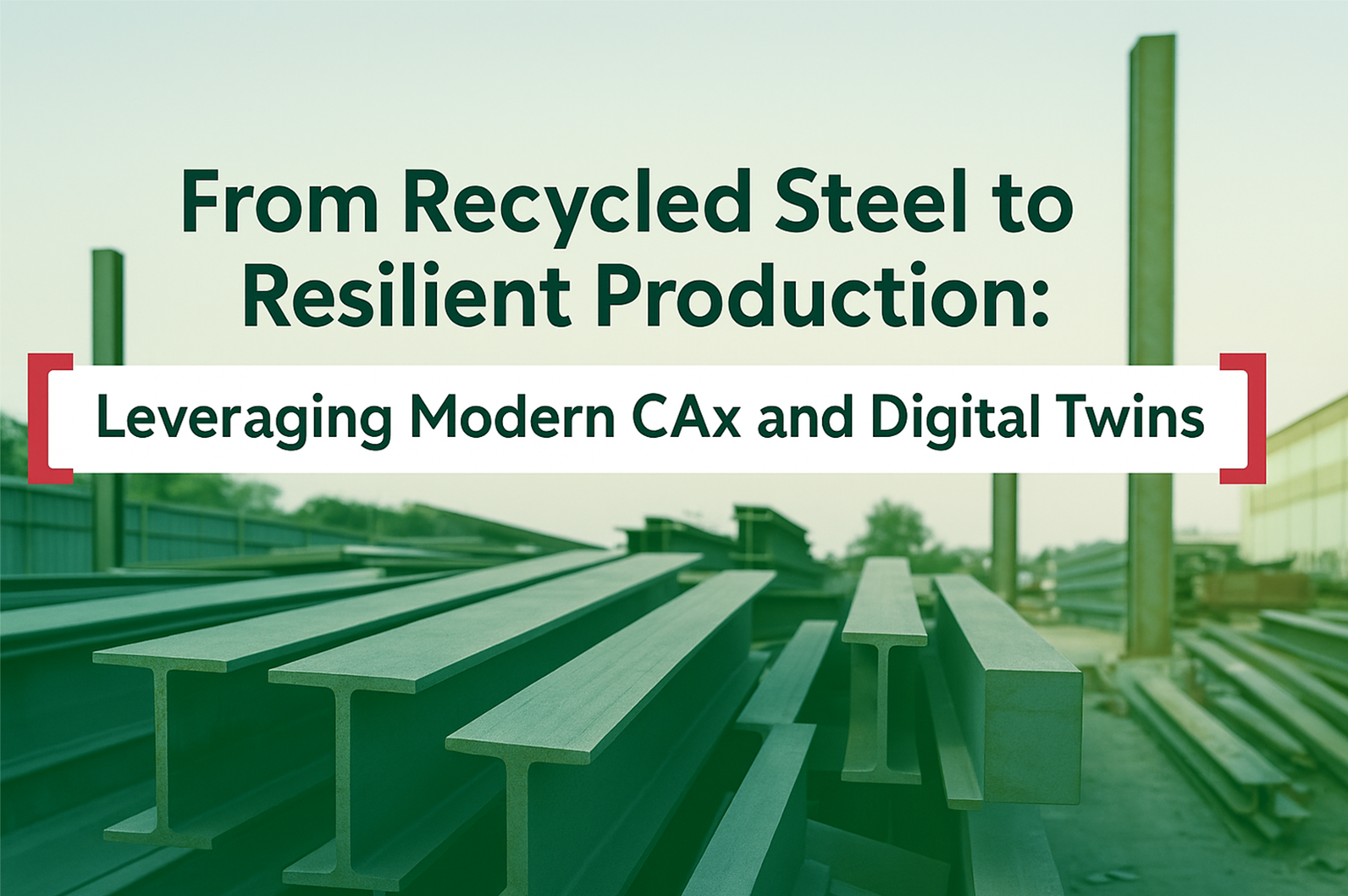
From Recycled Steel to Resilient Production: Leveraging Modern CAx and Digital Twins

The drive to decarbonize manufacturing has placed recycled (“green”) steel at the heart of sustainable innovation. Yet accommodating variable material properties in high-volume stamping demands an end-to-end digital strategy. Within the Dutch “Groeien met Groen Staal” (GGS) programme, a dedicated adaptive-stamping project—supported by Fraunhofer Innovation Platform for Advanced Manufacturing at the University of Twente (FIP-AM@UT) and carried out in collaboration with Tata Steel, Volvo, Philips and DevControl—demonstrates how a modern CAx-based digital-twin framework can deliver reliable, scalable forming of recycled-content alloys.
1. The Variability Challenge of Green Steel
Automotive panel stamping has long been optimised for steels with narrowly defined chemistry and mechanical properties. Green steels, by contrast, may exhibit significant scatter in yield strength, ductility and work-hardening behaviour. Left unaddressed, these variations lead to costly die reworks, elevated scrap rates and lengthy ramp-up times whenever a new coil arrives. We confront this head-on by embedding adaptability into every phase—from virtual design to shop-floor execution.
2. CAx-Driven Development and the Hybrid Digital Twin
At the core of our approach is an integrated CAx ecosystem that unites
• Parametric CAD for part, die and blank-holder design
• Advanced CAE for virtual validation
• Process planning for blank-layout optimisation
• Surrogate modelling for real-time prediction
• CAM for generating machine-executable control sequences
Only the most influence-critical features—draw-bead positions, flange heights and blank-holder contours—are exposed as software parameters, ensuring practical flexibility without undue complexity. Blank-shape algorithms automatically tailor sheet layouts to balance draw depths and suppress edge wrinkles across varied steel strengths.
High-fidelity finite-element analyses then quantify springback, thinning and wrinkle risk over a representative set of green-steel properties. Rather than relying solely on lengthy simulations, key input–output relationships (e.g., springback angle versus yield strength) are distilled to train lightweight surrogate models—Gaussian-process regressors or compact neural networks—that reproduce CAE results in milliseconds. Embedding these models back into the CAx platform yields a hybrid digital twin, combining predictive accuracy with real-time responsiveness.
3. CAx-Embedded Adaptive Control
What makes it adaptive? Traditional stamping lines run on static machine settings derived from offline trials; any shift in material behaviour is handled by manual tweaks and costly downtime. Adaptive control tunes those settings automatically—before and during each stroke—using live material data and in-process sensing.
Leveraging the hybrid digital twin inside a unified CAx environment, we deploy a feed-forward plus feedback loop that turns a conventional press into a self-optimising system.
• Feed-forward configuration
The twin ingests a coil’s digital material passport—true stress–strain curve, yield strength, thickness—and predicts how that batch will behave. Optimal draw-bead offsets, blank-holder force, ram speed and cushion pressure are computed and written straight into the CAM code, giving the press a tailored recipe from the first stroke.
• Feedback refinement
During forming, in-line sensors (force transducers, displacement probes, DIC cameras) stream live data back to the surrogate-powered twin. Millisecond-scale comparisons between predicted and actual behaviour trigger automatic tweaks to cam profiles, slide trajectories or blank-holder motion—closing the loop without human intervention.
By fusing an anticipatory feed-forward setup with an instantaneous feedback correction inside one CAx module, every coil—no matter how its properties vary—is formed under optimal conditions, eliminating manual die tweaks and safeguarding throughput.
4. Anticipated Benefits and Outlook
Pilot-line trials will demonstrate how each incoming coil can be stamped remarkably close to its intended geometry on the first try. We expect a clear jump in first-pass successes, a significant drop in scrap and rework, and far quicker change-overs whenever a new batch arrives. More broadly, this CAx-anchored digital-twin framework offers a flexible roadmap for near-zero-waste stamping of recycled steel—not just in automotive panels, but wherever high precision and sustainability go hand in hand.
5. Building Knowledge for the Future
The know-how and tooling developed at FIP-AM@UT, together with project partners and in close cooperation with other knowledge-development initiatives across GGS, form a transferable foundation for the next wave of manufacturing innovation. The same CAx methods, data pipelines and adaptive-control concepts can be extended to upcoming projects—whether they tackle multi-stage forming, lightweight alloys or entirely new product families—ensuring that the insights gained here continue to shape resilient, low-carbon production for years to come.

dr habil. Celal Soyarslan is an Associate Professor at the University of Twente’s Faculty of Engineering Technology and the Fraunhofer Innovation Platform for Advanced Manufacturing. His research spans cutting-edge areas including computational homogenisation, metamaterials, continuum mechanics, and advanced material modelling. He investigates the complex behaviour of solids under deformation and fracture, seamlessly integrating numerical simulations with experimental methods. With expertise in finite element analysis and algorithm development, he also advances manufacturing processes through hybrid approaches, bridging theoretical mechanics with practical engineering innovation.
